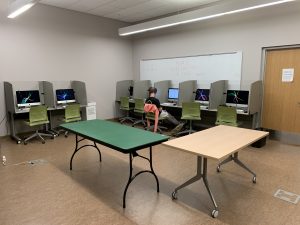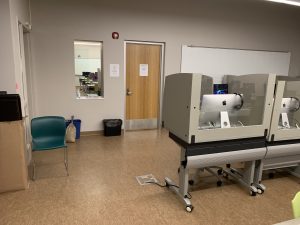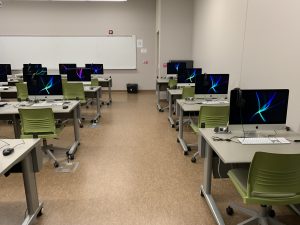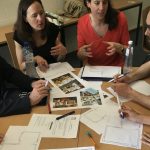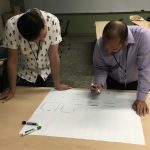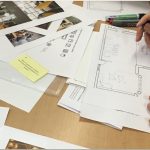The co-design project has begun! 11 co-designers are starting this month to re-envision the future of the CeLTA Labs. As the project unfolds, we will be posting new information (and pictures) on this page throughout the semester. The group will do a variety of co-design activities, including the following:
- learning space job descriptions activity
- group sketching
- prototyping
The call for round 1 (spring 2020) is closed now. We will send out the call for round 2 (fall 2020) during the summer. It will also be posted on this web site.
We invite you to participate in our CeLTA Labs Co-Design project. You do not have to be a design professional, architect, or building planner to join us in re-imagining a 21st century physical language learning space. Don’t just dream about the ideal learning space, make it (and help us assess it…)!1

Co-Design Project
In order to transform the current labs into innovative learning spaces for language learning, teaching, and research, it is important for us to listen to as many different voices from our stakeholders. Your voice in this process will be very valuable.
I am thankful to the Hub for the 2020/21 fellowship to make this project possible.
What is Co-Design?
Design processes executed exclusively by professionals and experts are more likely to be perceived as imposed upon or top-down. Co-design can increase the sense of ownership and belonging because it is more attuned to local cultures, diversity, and social needs.
Who can participate?
Anyone who has an interest in making the Labs a better space: faculty, staff, students, parents (of CLS students), those who maintain, clean, or work in the space.
Why is this project relevant?
- The current “CELTA Lab” spaces in Wells Hall at Michigan State University are an underused resource. In the age of ubiquitous computing, computer labs need to be re-examined. Furthermore, there has been an increased focus on intentional learning space design and research in higher education in recent years. It is time to reexamine what the best use of the space is.
- Post-occupancy assessment is good practice in learning space design. It is difficult to assess the usability of a space until it is actually used.
- Many things around us change all the time: technologies, academic programs, instructors, students, etc. It is important to make necessary adjustments from time to time.
- It is important to create sustainable spaces to save money and resources.
- Optimal learning spaces can create healthier and more productive work and learning environments.
- Impact and innovation: We can create 21st century learning spaces that have a real impact. We have the possibility to create and assess different learning spaces and share those findings with the world. If you consider that the average new high school costs about 100-150 million dollars and will exist for decades, research in this area can translate to real benefits beyond our spaces here at MSU.
- The co-design process involves all stakeholders. As such, it is guided by the Culture of Care Initiative. “The Culture of Care initiatives work to sustain inclusive practices as part of the core work of the College across all areas of endeavor, including teaching, scholarship, service, governance, leadership, professional development, and administration. Its goal is to support full participation in the activities of the college by a diverse cohort of faculty, staff, and students, where diversity encompasses, but is not limited to: rank or appointment type; area of artistic or scholarly endeavor with the arts and letters; identity and individual characteristics noted in the MSU Anti-Discrimination Policy.”
What is expected of me as a co-design participant?
Even though joining the co-design team is voluntary, we respectfully ask you to commit to some agreed-upon expectations:
- meet with the group for one hour per month until the end of the spring semester 2020
- fill out occasional questionnaires or surveys
- commit to a short interview once per semester
- be willing to join for at least one semester (or more if desired)
- come with an open mind and respect others’ opinions
What are the benefits?
While being a part of the team is not a paid position, we feel that this group can nonetheless offer some real benefits, such as
- working in a highly creative, diverse, and interdisciplinary team
- being a part of a team of change agents and support sustainability and cutting edge research in higher education
- seeing learning spaces change over time and have a tangible, real impact
- helping with creating models for other educational institutions in the U.S. and beyond
- learning more about the emerging field of learning space design
Learning space design at CeLTA and MSU
At CeLTA, our mission is to create models for transformation and innovation in language education. Our team includes expertise in different areas, such as Less commonly taught languages, indigenous languages, assessment, and our innovative MA program, physical learning spaces, to name just a few. Physical, virtual and hybrid spaces are another area in which we bring considerable expertise and connections.
The current state of the labs
Capacity utilization of the rooms is low, but some users make good use of the space: Courseshare courses, some specialized classes and research (e.g. in linguistics), and testing are the most important examples. Very few students use the rooms as a drop-in space.
Many usage scenarios, however, are currently not possible in the CeLTA Labs. For example, communicative classes are difficult to conduct in the fairly fixed design. CeLTA’s own Community Language School (CLS) classes are also not a good fit for these rooms, especially for smaller children.The spaces only marginally support CeLTA’s mission of innovation and transformation. Many features and affordances are absent, such as: visual recording and capturing for research and training; accessibility features; permeability features; placemaking features; etc.
